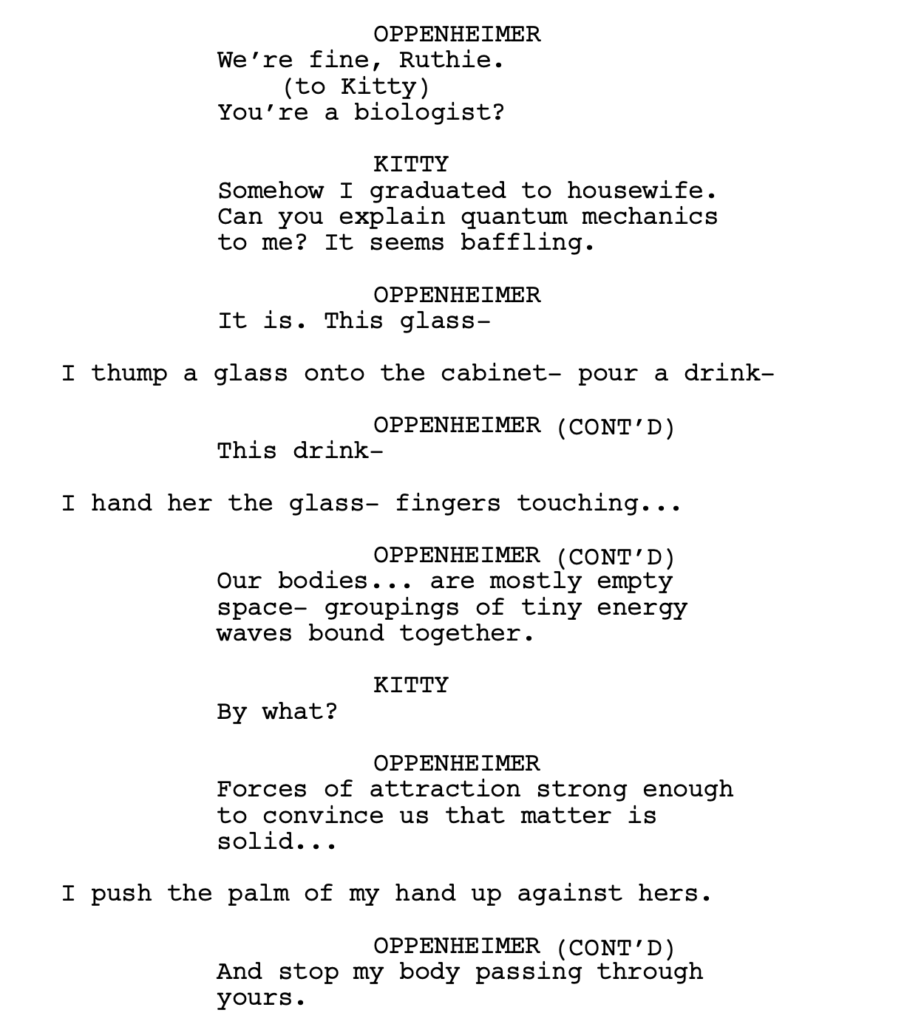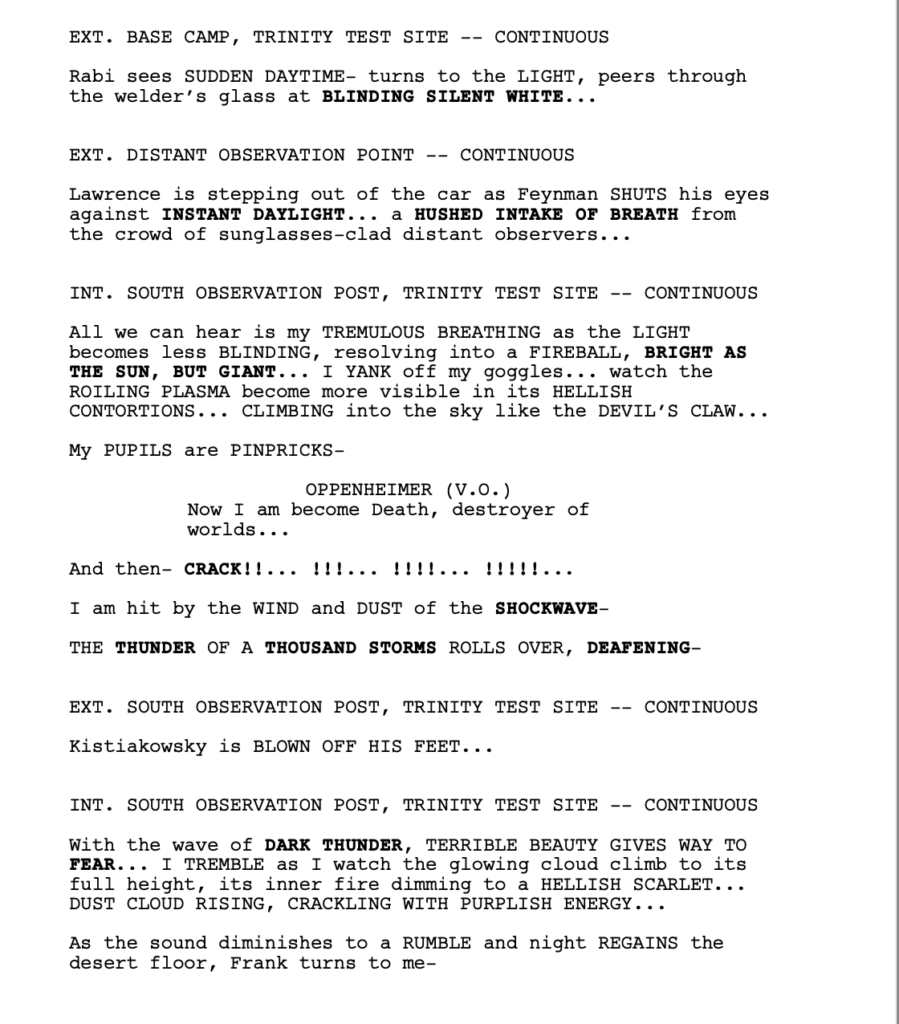Logline of Christopher Nolan’s Oppenheimer: Physicist J. Robert Oppenheimer and a team of scientists spend years developing the atomic bomb, forever changing the course of history.
Script Can Be Found Here
Summary of Oppenheimer:
Oppenheimer is an epic historical drama centering on two narratives. “Fission” follows J. Robert Oppenheimer (Cillian Murphy) at a hearing in front of the Atomic Energy Commission in the hopes of renewing his security clearance in 1954; this part of the narrative mainly exists in flashbacks that chronicle his personal and professional life as he developed the atomic bomb. “Fusion” centers on Lewis Strauss (Robert Downey Jr.)’s account of Oppenheimer given at his Senate confirmation hearing in 1959. As noted in the script and film, “Fission,” and its flashbacks, exists in color; “Fusion,” and its flashbacks, is filmed in black and white.
In 1926, Oppenheimer is a homesick and immature physicist student studying at Cambridge under Patrick Blackett, whom he almost poisons with an apple (and then regrets it and stops it), when Niels Bohr advises him to study theoretical physics at the University of Gottingen. After Gottingen, he meets Isidor Rabi in Holland and they go to Zurich to meet Heisenberg; afterwards, Oppenheimer begins teaching quantum theory at Cal Tech and Berkeley. While at Berkeley, his popularity grows as does his interest in the Communist Party (he attends gatherings where he meets and starts dating the troubled Jean Tatlock (Florence Pugh) as well as the alcoholic Kitty (Emily Blunt), his eventual wife). While there, he receives word that the Germans have split the uranium nucleus (a.k.a. fission) and works with Alvarez to weaponize it. When Hitler invades Poland, Oppenheimer and company realize that they need to move quickly.
Despite marital woes with Kitty, Oppenheimer’s career continues a strong trajectory. Colonel Groves (Matt Damon) recruits Oppenheimer to build a “a secret laboratory in the middle of nowhere” so that he and top scientists can work on the Manhattan Project. He also pushes for a town to be built around this lab so that scientists and their families can live and work there. Upon receiving approval, Oppenheimer recruits Lawrence, Serber, Teller, Bethe, Condon, Tolman, Feynman, Donald, Bainbridge, Neddermeyer and Alvarez. In running calculations, Teller discovers the possibility that their project could set up a catastrophic chain reaction that could potentially destroy the world. Oppenheimer checks Teller’s work with Einstein, who says that he should check with Bethe, who says that the odds are “near zero.” Under Oppenheimer, the scientists continue working but not without power struggles with fellow scientists (including Teller); Oppenheimer also receives word that Jean Tatlock committed suicide, etc.
Once Hitler is dead, Oppenheimer continues to lead his fellow scientists in the project, with the goal of directing it at Japan. When one scientist raises the issue of using it on human beings, Oppenheimer justifies the work noting that “We’re theorists- we can imagine a future, and our imaginings horrify us…our work will ensure a peace mankind has never seen. A peace based on the kind of international cooperation that Roosevelt always envisaged.” The scientists at Los Alamos then gear up for the Trinity Test in the desert which, although is considerably low-tech by today’s standards, proves successful and the results of which are later used on Hiroshima and Nagasaki.
The “success” for Oppenheimer is dubious, however. While he is lauded for his leadership, he is haunted by the incredible loss of human life. He meets with Truman and expresses that he feels like “he has blood on his hands” but Truman is dismissive. Oppenheimer wants to leave Los Alamos, but Truman wants him to stay and participate in the nuclear race against the Soviets. Oppenheimer also learns that one of his previous scientists at Los Alamos, Klaus Fuchs, was a Soviet spy.
In 1947, Oppenheimer meets Strauss at Princeton’s Institute for Advanced Study. After introducing Oppenheimer to Einstein, whom Oppenheimer already knows, Strauss comes to believe that Oppenheimer denigrated Strauss to Einstein. (A flashback at the end of the movie shows that the two did not talk about Strauss in particular; instead, Einstein talks about how the establishment will reward him with a perfunctory award, which it did, and Oppenheimer notes that they started a chain reaction that would change the entire world, which it did). Oppenheimer also publicly dismisses Strauss’ concerns regarding exporting radio isotopes and differed strongly in opinion pertaining to how the H-bomb would contribute to national security.
Despite Oppenheimer’s national acclaim, Lewis Strauss goes on the offensive, arranging for the private security hearing in 1954 regarding his Q clearance. During this hearing, many of Oppenheimer’s skeletons come out of the closet (i.e., previous ties to the Communist party, affair with Jean Tatlock, etc) and testimonies given by his previous colleagues are revoked. Oppenheimer’s security clearance is revoked.
During Strauss’ Senate confirmation hearing in 1959, David L. Hill (Rami Malek) gives the surprising testimony that Strauss’ personal vindictiveness drove the Oppenheimer hearing and that most scientists would like to see him out of government. Strauss is subsequently denied a Senate appointment.

What does Oppenheimer do well?
I’m not really a fan of longer screenplays in part because the longer the script and wider its scope, the less of an opportunity I have to get to know the protagonist and the most important people in his world.
Oppenheimer may do an excellent job of exploring his internal universe, particularly the guilt he has regarding the widescale destruction that came about from his creation, but I felt distracted by all of its supporting characters.
Nevertheless, here’s what I appreciate:
1. Plot Organization: Here’s something I’ve never seen before: using not one but two hearings as framing devices to tell the actual story. At his 1954 security hearing, Robert Oppenheimer gives an account of his life in color; at his 1959 Senate confirmation hearing, Strauss gives a recollection of Oppenheimer in black-and-white. (Interesting script formatting note: “Fusion” is written in italics, which I found helpful in keeping them apart). Naming them after the nuclear processes is clever, in particular because fission doesn’t just pertain to splitting the atom apart; it also pertains to how Oppenheimer’s personal world falls apart in terms of his affair, marriage, and career. This effect makes the truth somewhat more elusive, but both skeins seem to paint Strauss as the ultimate villain.
2. Foreshadowing: Oppenheimer poisoning the apple (and then stopping himself), noting that if stars die, “[they] cool, then collapse. And the bigger the star, the more violent its demise,” and proclaiming “And now I become Death…destroyer of worlds” all point to the Trinity Test (when he repeats the quote) and, more importantly, the global and personal aftermath of the completed Manhattan Project. Similarly, after Jean and Oppie say good-bye, the deathly visual of “Hot bath running. Pill bottle. Downturned heard in the water” portend to Jean’s suicide and the “the sound of feet stamping, stamping…” foretell the victory rally once the bomb has been dropped. Given all of these omens, it seems like Oppenheimer knows his fate, like he was born to be the Prometheus who’s eternally destined to be “tortured for eternity.” What’s interesting is that the stamping feet and “light of a thousand suns” occur again at the end of the narrative, in particular at the end of Oppenheimer’s security clearance hearing. Now that the physical A-bombs have been dropped, these foreshadowing devices are now occurring as quasi-flashbacks; Oppenheimer will be forever stuck with the consequences of his actions.
3. Subtext: Never did I think that quantum mechanics could be used as a pick-up line, but check out this first exchange between Oppie and Kitty.

I’d assume that most of the general audience would want a layman’s version of what quantum mechanics is without being bored to tears. (Explaining it in a cheeky, flirtatious way is quite the way to sell it).
4. Momentum: The piece really got going, for me at least, when the announcements of the Germans splitting the uranium nucleus and Hitler’s invasion of Poland. Because Oppenheimer and some of the other scientists were Jewish, the narrative felt like it really began to take off here with high stakes for the scientists involved (as well as the world). (Nevertheless, the power struggles among the scientists and the government slowed the plot down; I only wish the Trinity Test would’ve occurred faster.)
5. Subjective Vision: When Jean Tatlock appears in the courtroom (to have sex with Oppenheimer), the hearing members don’t see her, but Kitty does. It’s a powerful juxtaposition with the scene in which Jean and Oppenheimer sit across from each other in the hotel room; it also begs the question, is it just Oppenheimer’s point-of-view? Or, is it also Kitty’s? Regardless, it’s an incredible representation of Oppenheimer (and Kitty) feeling the most vulnerable during the hearing.
6. This Description of the Trinity Test: Succinct yet powerful.

7. Moral Complexity: As I found myself rooting for the scientists to develop the bomb to defeat the Nazis, I stopped myself – how could I be rooting for something that could (and did) kill thousands upon thousands of innocent civilians? As the scientists got closer to the Trinity Test (and beyond), it was compelling to watch Oppenheimer demonstrate such calm leadership when, what he was doing, was building something that would cause mass annihilation? When the film portrayed Oppenheimer’s tormenting psychological aftermath (and him expressing his feelings about that towards Truman), that’s when I really got a better sense of Oppenheimer the human.
8. Hollywood Sees Itself – Many aspects of Oppenheimer felt like a mirror of Hollywood. A tormented, philandering genius battles a team of egos to throw together an audacious, never-before-seen, large-scale project in a short amount of time? Uh, that’s basically every movie that’s ever been made. A conservative, McCarthy-era hearing grilling said genius about Communist activity? Talk about giving major HUAC vibes. That it takes place in the realm of government and physics doesn’t matter; what this piece is really about is creativity and pushing the limits while doing something new (which is something anyone who’s creative – whether in Hollywood or not – likes to do).
I can appreciate the film’s audacity in exploring Oppenheimer, particularly the messiness of his personal life and how, despite his contribution, he still wasn’t exempt from political blacklisting.
It also felt like the real enemy in this piece was more internal than external. Yes, tens of thousands of people died as a result of the Manhattan Project, and that cannot be understated. However, Oppenheimer’s destructive tendencies, conscience, and Strauss’s vindictive ego felt like they were the real enemies here.

